22 countries you'll no longer find on maps
Nations that are no more

N. Sitnikov/Hulton Archive/Getty
Since history began, nations have risen and fallen in their hundreds. From city states and countries forced into existence to long-gone kingdoms, click or scroll on as we take a look at how 22 countries have disappeared and the surprising reasons why.
Republic of Venice (697–1797)
![<p>Gentile Bellini [Public domain or CC BY-SA 4.0 (https://creativecommons.org/licenses/by-sa/4.0)]</p>](https://s.yimg.com/ny/api/res/1.2/IXYnE_XTGWQU8K1J7g00Qg--/YXBwaWQ9aGlnaGxhbmRlcjt3PTk2MDtoPTYxOQ--/https://media.zenfs.com/en/loveexploring_uk_835/c42122b9dbbe3301073bbdd1c4af1703)
Gentile Bellini [Public domain or CC BY-SA 4.0 (https://creativecommons.org/licenses/by-sa/4.0)]
The Most Serene Republic of Venice thrived for more than a millennium. Founded in 697, the iconic city-state became a hugely influential maritime and economic power, enabling its fabulously wealthy merchant class to spend lavishly on beautiful buildings and art.
Republic of Venice (697–1797)
![<p>Attributed to Canaletto [Public domain]</p>](https://s.yimg.com/ny/api/res/1.2/IyrCRBa6YzmzhiRSjchHNA--/YXBwaWQ9aGlnaGxhbmRlcjt3PTk2MDtoPTYxOQ--/https://media.zenfs.com/en/loveexploring_uk_835/a191e72a22eb5fb71f0cd26891421c0d)
Attributed to Canaletto [Public domain]
At its peak, Venice spanned modern-day northeastern Italy and parts of Croatia, Albania and Greece. The republic's power waned in the 18th century as new maritime trade routes opened up. A series of crushing defeats decimated the navy, and Venice was overrun by French and Austrian troops in 1797. It was subsequently divided up between the respective empires.
Couto Mixto (c.900–1864)
![<p>CorreiaPM [Public domain], from Wikimedia Commons</p>](https://s.yimg.com/ny/api/res/1.2/PN6YOPvd0Jewwkf27AaLaw--/YXBwaWQ9aGlnaGxhbmRlcjt3PTk2MDtoPTYxOQ--/https://media.zenfs.com/en/loveexploring_uk_835/a1b01a2f7a7397a1b684d7298f40943f)
CorreiaPM [Public domain], from Wikimedia Commons
Wedged between Spain and Portugal in northwestern Iberia, this tiny microstate operated as a free and independent nation for a staggering seven centuries due to a quirk in medieval manorial relations, which put it outside the control of both countries.
Couto Mixto (c.900–1864)
![<p>CorreiaPM [Public domain], from Wikimedia Commons</p>](https://s.yimg.com/ny/api/res/1.2/SrcFsaYwLjTrehwsdl7BaQ--/YXBwaWQ9aGlnaGxhbmRlcjt3PTk2MDtoPTYxOQ--/https://media.zenfs.com/en/loveexploring_uk_835/84b29dcdce92f0d5d0ce771a360c83cb)
CorreiaPM [Public domain], from Wikimedia Commons
Made up of three miniscule villages, Couto Mixto enjoyed all sorts of privileges, from tax-free status to the right to grant asylum. This special treatment was never going to last forever of course, and the microstate was finally abolished by the Treaty of Lisbon in 1864.
Kingdom of Bohemia (1198–1918)
![<p>Dr.J. Kosina; Jiljí Sadeler (1607) [Public domain], via Wikimedia Commons</p>](https://s.yimg.com/ny/api/res/1.2/e6X860WOijZkvc2c31e2lQ--/YXBwaWQ9aGlnaGxhbmRlcjt3PTk2MDtoPTYxOQ--/https://media.zenfs.com/en/loveexploring_uk_835/51d3269f5bd3eb7a75e142723bd7523b)
Dr.J. Kosina; Jiljí Sadeler (1607) [Public domain], via Wikimedia Commons
This venerable kingdom, which more or less covered the modern-day Czech Republic, was established at the end of the 12th century by the royal House of Přemyslid. It formed part of the Holy Roman Empire, a complex of largely independent states that spanned central Europe.
Kingdom of Bohemia (1198–1918)
![<p>Unknown author [Public domain], via Wikimedia Commons</p>](https://s.yimg.com/ny/api/res/1.2/RzCIPBL9H29ZytJFvr63QA--/YXBwaWQ9aGlnaGxhbmRlcjt3PTk2MDtoPTYxOQ--/https://media.zenfs.com/en/loveexploring_uk_835/de28663898c432cffe941a81f44714ee)
Unknown author [Public domain], via Wikimedia Commons
The kingdom was at its height during the so-called Golden Age of Czech history in the 14th century. When the Holy Roman Empire collapsed in 1806, Bohemia was absorbed into the Austrian Empire, and survived until 1918 when it formed the integral part of the newly-created Czechoslovakia.
Abyssinia (1270–1974)
![<p>Unknown author [Public domain], via Wikimedia Commons</p>](https://s.yimg.com/ny/api/res/1.2/D3d0_R7Ep4qO7B3WjSBNfA--/YXBwaWQ9aGlnaGxhbmRlcjt3PTk2MDtoPTYxOQ--/https://media.zenfs.com/en/loveexploring_uk_835/cfc822ac06abcd2e9b2fc7e190cb5024)
Unknown author [Public domain], via Wikimedia Commons
Abyssinia, aka the Ethiopian Empire, was a kingdom that encompassed what is modern-day Ethiopia and, later down the line, Eritrea. It endured for seven centuries. The nation was controlled by the Solomonic Dynasty, who claimed descent from the Biblical King Solomon and Queen of Sheba.
Abyssinia (1270–1974)
![<p>unknown; according to [1] and [2] an official portrait of which b/w copies were distributed by the Ethiopian government [Public domain], via Wikimedia Commons</p>](https://s.yimg.com/ny/api/res/1.2/pg_swgAGd3oX7kWZZiHsVQ--/YXBwaWQ9aGlnaGxhbmRlcjt3PTk2MDtoPTYxOQ--/https://media.zenfs.com/en/loveexploring_uk_835/bd8061086a7fcf05c5a4dc1f57b8f264)
unknown; according to [1] and [2] an official portrait of which b/w copies were distributed by the Ethiopian government [Public domain], via Wikimedia Commons
Abyssinia was the only African nation aside from Liberia to resist colonisation during the 19th-century Scramble for Africa, and existed until 1974, when Emperor Haile Selassie was deposed by the communist Derg, which went on to establish the People's Republic of Ethiopia.
Kingdom of Sardinia (1324–1861)
![<p>Sigismondo Asquer [Public domain], via Wikimedia Commons</p>](https://s.yimg.com/ny/api/res/1.2/LQ6JzKtik2xpFg576wg41Q--/YXBwaWQ9aGlnaGxhbmRlcjt3PTk2MDtoPTYxOQ--/https://media.zenfs.com/en/loveexploring_uk_835/2eb1679d97f989a0ba157a9bdec30b2c)
Sigismondo Asquer [Public domain], via Wikimedia Commons
The precursor to modern Italy, the Kingdom of Sardinia was created in 1324 by James II of Aragon and went on to become part of the Spanish Empire. It was ceded in 1720 to the Duke of Savoy, who unified the territory with his possessions on the Italian mainland.
Kingdom of Sardinia (1324–1861)
![<p>http://gianfrancopintore.blogspot.com/2011/02/sudtirolesi-non-contate-su-noi-per-il.html [CC BY-SA 3.0 (https://creativecommons.org/licenses/by-sa/3.0)], via Wikimedia Commons</p>](https://s.yimg.com/ny/api/res/1.2/Uu6MoS6cZON7MYJyDgtL4w--/YXBwaWQ9aGlnaGxhbmRlcjt3PTk2MDtoPTYxOQ--/https://media.zenfs.com/en/loveexploring_uk_835/a0f9ffd188d5340310db7019b406607b)
http://gianfrancopintore.blogspot.com/2011/02/sudtirolesi-non-contate-su-noi-per-il.html [CC BY-SA 3.0 (https://creativecommons.org/licenses/by-sa/3.0)], via Wikimedia Commons
The kingdom was united under a single system in 1848 and had annexed Lombardy, the Kingdom of the Two Sicilies and the central Italian states by 1861. That same year, the Kingdom of Sardinia changed its name to the Kingdom of Italy, and the capital was moved from Turin to Florence and, eventually, Rome.
Moldavia (1346–1859)
![<p>Post of Moldova [Public domain], via Wikimedia Commons</p>](https://s.yimg.com/ny/api/res/1.2/TpLR6c8I3kS1YKYGqleHnQ--/YXBwaWQ9aGlnaGxhbmRlcjt3PTk2MDtoPTYxOQ--/https://media.zenfs.com/en/loveexploring_uk_835/5fb256996b364c129f5c891404bc9489)
Post of Moldova [Public domain], via Wikimedia Commons
Located in modern-day Romania, Moldova and the Ukraine, the Principality of Moldavia was founded in 1346 and remained an independent state until ruler Bogdan III The One-Eyed submitted to Ottoman rule in 1514.
Moldavia (1346–1859)
![<p>Constantin Lecca [Public domain]</p>](https://s.yimg.com/ny/api/res/1.2/blqd5b9DXraii_kLvfATYQ--/YXBwaWQ9aGlnaGxhbmRlcjt3PTk2MDtoPTYxOQ--/https://media.zenfs.com/en/loveexploring_uk_835/3fc0e3d25f749317813ecff65336c516)
Constantin Lecca [Public domain]
Moldavia nevertheless enjoyed a great degree of autonomy, and was a distinct country for centuries. The nation's end came in 1859 when it merged with Wallachia, and went on to form the basis of modern Romania.
Ayutthaya Kingdom (1351–1767)
![<p>Johannes Vingboons [Public domain, Public domain or CC0]</p>](https://s.yimg.com/ny/api/res/1.2/YGAlmeilDsUCsi95DzRz1Q--/YXBwaWQ9aGlnaGxhbmRlcjt3PTk2MDtoPTYxOQ--/https://media.zenfs.com/en/loveexploring_uk_835/8a3766d29e506c7bb368b1dc0f9eaec3)
Johannes Vingboons [Public domain, Public domain or CC0]
The Ayutthaya Kingdom, which comprised much of modern-day Thailand, had become richer than many European nations by the 17th century. The Siamese kingdom was a centre of international trade and its eponymous capital rivalled Paris in size and splendour.
Ayutthaya Kingdom (1351–1767)
![<p>Wagaung at the English Wikipedia [GFDL (http://www.gnu.org/copyleft/fdl.html) or CC-BY-SA-3.0 (http://creativecommons.org/licenses/by-sa/3.0/)]</p>](https://s.yimg.com/ny/api/res/1.2/jPcIKSfsve_IKfnvMtoJxw--/YXBwaWQ9aGlnaGxhbmRlcjt3PTk2MDtoPTYxOQ--/https://media.zenfs.com/en/loveexploring_uk_835/87641042ad4b9f26caf0d361984e077b)
Wagaung at the English Wikipedia [GFDL (http://www.gnu.org/copyleft/fdl.html) or CC-BY-SA-3.0 (http://creativecommons.org/licenses/by-sa/3.0/)]
Sadly, the boom times didn't last. Trade declined in the early 18th century, and a bloody game of thrones ensued. Weakened by economic strife and political instability, Ayutthaya was besieged by the Burmese army in 1765 and fell in 1767, marking the end of the once-glorious realm.
Merina Kingdom (1540–1897)
![<p>Internet Archive Book Images [No restrictions], via Wikimedia Commons</p>](https://s.yimg.com/ny/api/res/1.2/gQKHc_Kz__hx2jIwQyeYEA--/YXBwaWQ9aGlnaGxhbmRlcjt3PTk2MDtoPTYxOQ--/https://media.zenfs.com/en/loveexploring_uk_835/d5fba8a0f88112de7ea5b387fd92e390)
Internet Archive Book Images [No restrictions], via Wikimedia Commons
The Merina Kingdom was founded in 1540 by King Andriamanelo and covered most of Madagascar at its apex. The Merina kings and queens are credited with advancing agriculture on the island and initiating trade with Europe.
Merina Kingdom (1540–1897)
![<p>Unknown author [Public domain], via Wikimedia Commons</p>](https://s.yimg.com/ny/api/res/1.2/ywVYLdjwaq45VtHbej6OJA--/YXBwaWQ9aGlnaGxhbmRlcjt3PTk2MDtoPTYxOQ--/https://media.zenfs.com/en/loveexploring_uk_835/5940d9775559225f92135a0610aeafe4)
Unknown author [Public domain], via Wikimedia Commons
One of the victims of the 19th-century Scramble for Africa, the kingdom was invaded by France in 1883 and colonised in 1897, when it became known as the Malagasy Protectorate. Its last ruler Queen Ranavalona III was exiled to French Algeria, where she died in 1917.
Kingdom of Dahomey (c.1600–1894)
![<p>Archibad Dalzel [Public domain], via Wikimedia Commons</p>](https://s.yimg.com/ny/api/res/1.2/.pVxJuJWLOMYwO0D6NI.nA--/YXBwaWQ9aGlnaGxhbmRlcjt3PTk2MDtoPTYxOQ--/https://media.zenfs.com/en/loveexploring_uk_835/b3765ccb08394a40ee15056f0464771a)
Archibad Dalzel [Public domain], via Wikimedia Commons
Located in modern-day Benin, the Kingdom of Dahomey was established around 1600 by the Fon people and grew to become a major regional power. Its economy was built on slavery and trade, and the country boomed as an independent state for several centuries.
Kingdom of Dahomey (c.1600–1894)
![<p>Alexandre d'Albéca [Public domain]</p>](https://s.yimg.com/ny/api/res/1.2/KTxYrZzeSeUqI2hnrHjrnQ--/YXBwaWQ9aGlnaGxhbmRlcjt3PTk2MDtoPTYxOQ--/https://media.zenfs.com/en/loveexploring_uk_835/3ee098b49dcbba652ed673934688b2a1)
Alexandre d'Albéca [Public domain]
The kingdom was famous for its female Amazon warriors and cultivated a fearsome reputation, holding annual ritual celebrations that involved mass human sacrifice. Still, Dahomey succumbed to the European Scramble for Africa, falling in 1893 after King Béhanzin's troops were defeated by French forces at the Battle of Cana.
Kingdom of Hawaii (1795–1893)
![<p>Louis Choris [Public domain]</p>](https://s.yimg.com/ny/api/res/1.2/Va4j1P6amtEb1CGR_rIDBg--/YXBwaWQ9aGlnaGxhbmRlcjt3PTk2MDtoPTYxOQ--/https://media.zenfs.com/en/loveexploring_uk_835/000697aa0060a258af1ea9c477278223)
Louis Choris [Public domain]
The Kingdom of Hawaii was formed in 1795 when the island states of Hawaii, Oahu, Maui, Molokai and Lanai united under King Kamehameha the Great. A vulnerable nation located in a strategically important location, the kingdom resisted attempts at colonisation by the British and French.
Kingdom of Hawaii (1795–1893)
![<p>James J. Williams [Public domain]</p>](https://s.yimg.com/ny/api/res/1.2/clzsuuO0TYg7bP0jYAXvSg--/YXBwaWQ9aGlnaGxhbmRlcjt3PTk2MDtoPTYxOQ--/https://media.zenfs.com/en/loveexploring_uk_835/b2d028888e9b18a4dcd0e4eb95c231c9)
James J. Williams [Public domain]
The US was concerned Hawaii would be grabbed by a rival and wanted to prevent the monarchy rewriting the country's constitution to the detriment of American business interests. It backed a coup against Queen Liliʻuokalani in 1893 and went on to annex the kingdom in 1897.
Gran Colombia (1819–1831)
![<p>Iamcharles66 [CC BY-SA 4.0 (https://creativecommons.org/licenses/by-sa/4.0) or Public domain], from Wikimedia Commons</p>](https://s.yimg.com/ny/api/res/1.2/6rL58ouMtrQ.PraSTEHPBg--/YXBwaWQ9aGlnaGxhbmRlcjt3PTk2MDtoPTYxOQ--/https://media.zenfs.com/en/loveexploring_uk_835/15eb435aa76d2ec00cca81764058bc7e)
Iamcharles66 [CC BY-SA 4.0 (https://creativecommons.org/licenses/by-sa/4.0) or Public domain], from Wikimedia Commons
Inspired by the ideas of the Enlightenment, Venezuelan military leader Simón Bolívar launched a campaign in 1808 to liberate his country from Spanish rule, and went on to defeat the colonial power during the Venezuelan War of Independence.
Gran Colombia (1819–1831)
![<p>Agostino Codazzi [Public domain]</p>](https://s.yimg.com/ny/api/res/1.2/XcsyhrEsS8AU5EkW4.soiA--/YXBwaWQ9aGlnaGxhbmRlcjt3PTk2MDtoPTYxOQ--/https://media.zenfs.com/en/loveexploring_uk_835/79e3462eca118719e331188e8397fe90)
Agostino Codazzi [Public domain]
In 1819, the newly independent union of Gran Colombia was created, which included Venezuela, Colombia, Ecuador and parts of Peru. Despite Bolívar's best efforts, the union was marked by internal division and, after a period of just 12 years, the supersized nation was dissolved.
Republic of Texas (1836–1846)
![<p>Bureau of Engraving and Printing [Public domain], via Wikimedia Commons</p>](https://s.yimg.com/ny/api/res/1.2/tQDl.Spclh8iq719tpICNQ--/YXBwaWQ9aGlnaGxhbmRlcjt3PTk2MDtoPTYxOQ--/https://media.zenfs.com/en/loveexploring_uk_835/f4f24659f516b1bfc338a2a2b350c797)
Bureau of Engraving and Printing [Public domain], via Wikimedia Commons
The independent Republic of Texas didn't even last that long. The province, which extended over modern-day Texas and claimed parts of Oklahoma, Kansas, New Mexico, Colorado and Wyoming, had a large population of US settlers and broke away from Mexico in 1836 during the Texas Revolution.
Republic of Texas (1836–1846)
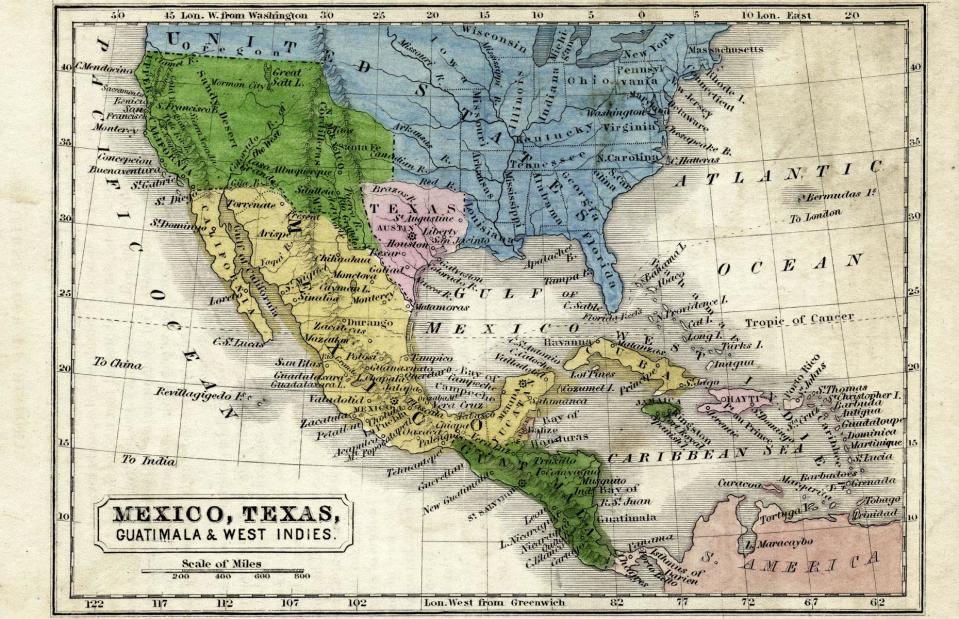
Steven Wright/Shutterstock
Mexico refused to recognise the country and was a constant threat. Fearing an invasion, a majority of Texians favoured annexation by the US. Despite initial opposition from the American government, which was reluctant at first to absorb a heavily indebted slave-owning territory, Texas was annexed in 1846, becoming the 28th state.
Confederate States of America (1861–1865)
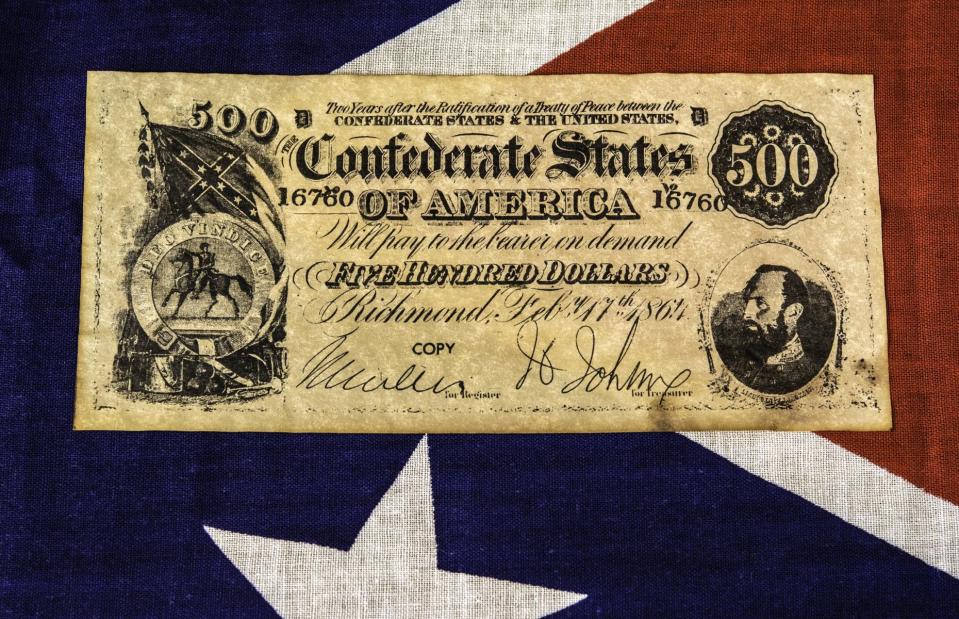
Robert Hale/Shutterstock
The Confederacy was formed by seven slave-holding American states in February 1861 following the inauguration of President Abraham Lincoln, who had campaigned on an anti-slavery platform. The unrecognised breakaway country grew to include a total of 11 Southern states.
Confederate States of America (1861–1865)
![<p>Published by Currier & Ives [Public domain], via Wikimedia Commons</p>](https://s.yimg.com/ny/api/res/1.2/Z3dDGnyhhjCsp4GgZsqI7Q--/YXBwaWQ9aGlnaGxhbmRlcjt3PTk2MDtoPTYxOQ--/https://media.zenfs.com/en/loveexploring_uk_835/bcc85dc320bcc5ced4915235256c872e)
Published by Currier & Ives [Public domain], via Wikimedia Commons
Desperate to hold on to its slaves, the Confederacy attacked Union forces at Fort Sumter in April 1861, triggering the American Civil War. After four years of fighting, the South surrendered and the short-lived Confederacy was no more. The 13th Amendment passed that same year, outlawing slavery in the nation.
Austria-Hungary (1867–1918)
![<p>Deutsches Historisches Museum [Public domain]</p>](https://s.yimg.com/ny/api/res/1.2/Mqf.xYZXpfkyeK7XPKXmOg--/YXBwaWQ9aGlnaGxhbmRlcjt3PTk2MDtoPTYxOQ--/https://media.zenfs.com/en/loveexploring_uk_835/74b8231bacf33f5b3987751a6d77f7fb)
Deutsches Historisches Museum [Public domain]
The Austrian Empire was devastated by the Austro-Prussian War of 1866 and forced to enter a mutually beneficial union with its neighbour the Kingdom of Hungary the following year. A force to be reckoned with, Austria-Hungary became a key European power player.
Austria-Hungary (1867–1918)
![<p>Unknown author [Public domain or Public domain], via Wikimedia Commons</p>](https://s.yimg.com/ny/api/res/1.2/AtKetAWtnm81eqrDPmB2eA--/YXBwaWQ9aGlnaGxhbmRlcjt3PTk2MDtoPTYxOQ--/https://media.zenfs.com/en/loveexploring_uk_835/01cc9bf9a1dfd27a5189bc3b386bf96a)
Unknown author [Public domain or Public domain], via Wikimedia Commons
As well as boasting enviable military prowess, Austria-Hungary was one of the world's leading manufacturing countries. It may well have survived until the present day, but the nation was on the losing side in the First World War, and ended up being dissolved in 1918.
Tibet (1912–1951)
![<p>Unknown author [Public domain], via Wikimedia Commons</p>](https://s.yimg.com/ny/api/res/1.2/Cs68sccT0EmGcW3x_kah8Q--/YXBwaWQ9aGlnaGxhbmRlcjt3PTk2MDtoPTYxOQ--/https://media.zenfs.com/en/loveexploring_uk_835/586130b9eaa82fc82e95521a5bf4273d)
Unknown author [Public domain], via Wikimedia Commons
The ancient region of Tibet achieved de facto independence in 1912 after the fall of China's Qing Dynasty. Imperial Chinese troops were ejected and the 13th Dalai Lama declared independence the following year. Though officially a protectorate of China, Tibet enjoyed considerable autonomy.
Tibet (1912–1951)
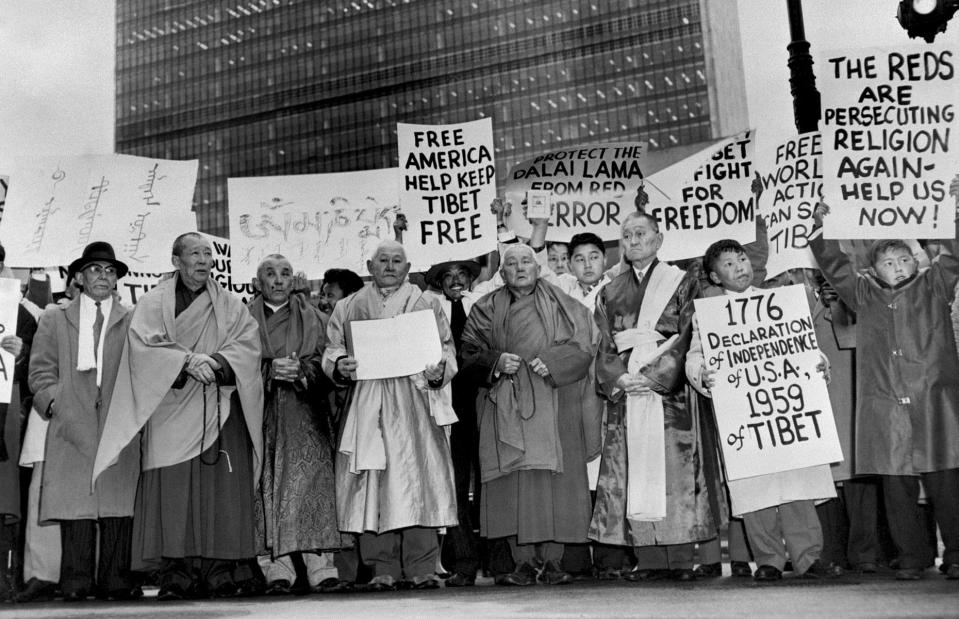
AFP/Getty
This all came crashing down when the Chinese Communist Party defeated the Nationalist government in the Chinese Civil War. In 1950, the People's Liberation Army entered Tibet, asserted Beijing's authority over the region and ended its de facto independence the following year. Many people today still view it as an independent country though.
Yugoslavia (1918–1992)
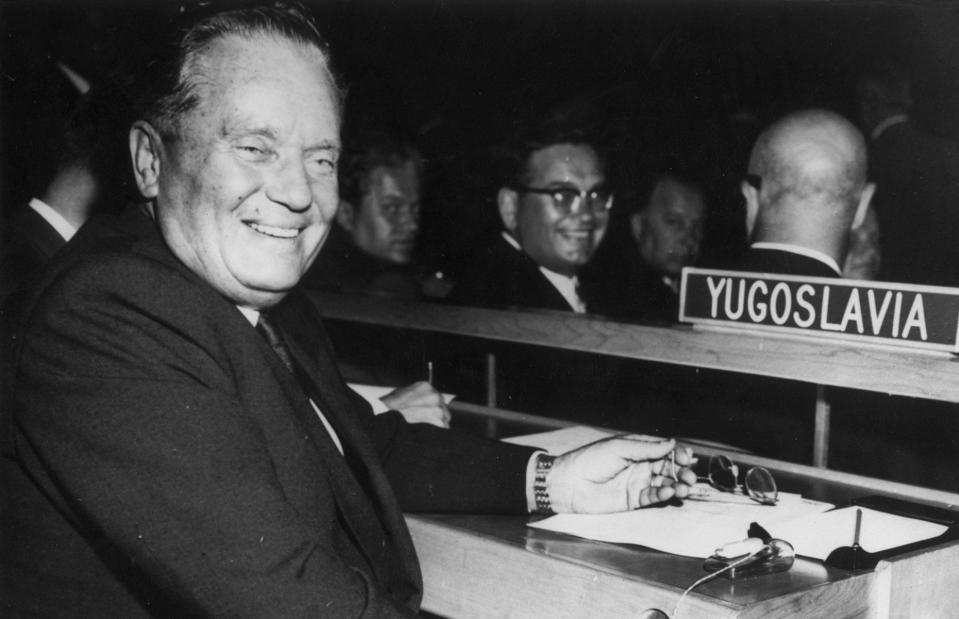
Keystone/Getty
Yugoslavia ('Land of Southern Slavs') came into being in 1918 following the collapse of Austria-Hungary. The country was a kingdom until the Second World War when King Peter II was deposed and Yugoslavia became a socialist republic under dictator Josip Broz Tito.
Yugoslavia (1918–1992)
![<p>SSGT KIM PRICE [Public domain], via Wikimedia Commons</p>](https://s.yimg.com/ny/api/res/1.2/Ngi5.T1fNTlfXcyRm2wgfQ--/YXBwaWQ9aGlnaGxhbmRlcjt3PTk2MDtoPTYxOQ--/https://media.zenfs.com/en/loveexploring_uk_835/f33b3eb2282f72a560fcda7a79362490)
SSGT KIM PRICE [Public domain], via Wikimedia Commons
Tito was successful in holding the country together but, after his death in 1980, simmering ethnic tensions came to the fore as the economy faltered. Slovenia and Croatia declared independence in 1991, and the bitter Yugoslav Wars that followed led to the break-up of the nation in 1992.
Czechoslovakia (1918–1992)
![<p>Unknown author [Public domain], via Wikimedia Commons</p>](https://s.yimg.com/ny/api/res/1.2/5WXyb4xXm2rRuaHqCdoKlg--/YXBwaWQ9aGlnaGxhbmRlcjt3PTk2MDtoPTYxOQ--/https://media.zenfs.com/en/loveexploring_uk_835/1cf1dc6eac0fce5d44e16c343acb82dc)
Unknown author [Public domain], via Wikimedia Commons
Carved out of former territories of Austria-Hungary that included the Kingdom of Bohemia, Czechoslovakia was born in 1918. The Central European nation started out as a democratic republic but became a communist satellite state of the USSR in 1946.
Czechoslovakia (1918–1992)
![<p>Péter Antall [CC BY-SA 3.0 (https://creativecommons.org/licenses/by-sa/3.0)], via Wikimedia Commons</p>](https://s.yimg.com/ny/api/res/1.2/Xqbb6oDCwMTTHvckHKDceQ--/YXBwaWQ9aGlnaGxhbmRlcjt3PTk2MDtoPTYxOQ--/https://media.zenfs.com/en/loveexploring_uk_835/dda828f1e4fa28012b9df2a3c1a55c66)
Péter Antall [CC BY-SA 3.0 (https://creativecommons.org/licenses/by-sa/3.0)], via Wikimedia Commons
The nation remained communist until 1989 when the peaceful Velvet Revolution ended one-party rule. This was followed by increasing nationalist sentiment among Czechs and Slovaks, which prompted the dissolution of the country in 1992 and its split the following year into two sovereign states: the Czech Republic and Slovakia.
Union of Soviet Socialist Republics (1922–1991)

N. Sitnikov/Hulton Archive/Getty
A key 20th-century superpower, the USSR was formed in 1922 following a brutal civil war that ended in victory for the communist 'Reds'. A one-party state made up of numerous Soviet republics, the vast nation was at odds with the capitalist West since its inception.
Union of Soviet Socialist Republics (1922–1991)
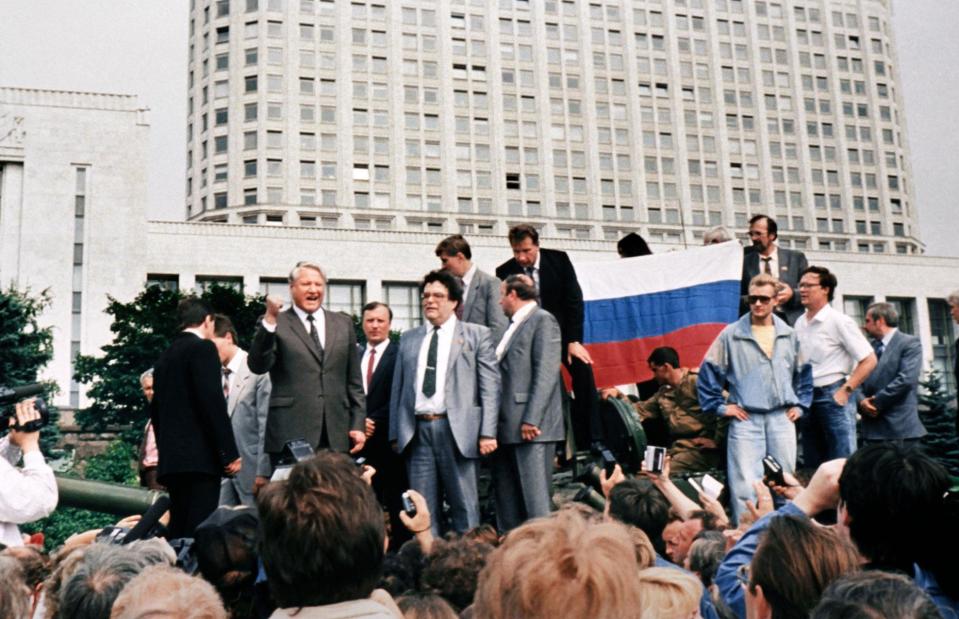
Diane Lu-Hovasse/AFP/Getty
This clash of ideologies culminated in the Cold War, which brought the world to the brink of nuclear conflict. The country's rigid communist ethos spelled its downfall. By the 1980s, its economy and political system were crumbling. The death knell came in 1989 with the Fall of Communism in Eastern Europe, and the USSR was formally dissolved in 1991.
East Germany (1949–1990)
![<p>Edward Valachovic https://www.flickr.com/people/fauxaddress/ [CC BY-SA 2.0 (https://creativecommons.org/licenses/by-sa/2.0)], via Wikimedia Commons</p>](https://s.yimg.com/ny/api/res/1.2/vlZxJX905GipTp8pofXWig--/YXBwaWQ9aGlnaGxhbmRlcjt3PTk2MDtoPTYxOQ--/https://media.zenfs.com/en/loveexploring_uk_835/038d1a64e38282f1f4d3102bbe785d69)
Edward Valachovic https://www.flickr.com/people/fauxaddress/ [CC BY-SA 2.0 (https://creativecommons.org/licenses/by-sa/2.0)], via Wikimedia Commons
Germany was split into three Western zones and a single Soviet zone following the Second World War. The Western zones formed the Federal Republic of Germany, aka West Germany, while the Soviet zone became the German Democratic Republic or East Germany.
East Germany (1949–1990)
![<p>Frits Wiarda [CC BY-SA 3.0 (https://creativecommons.org/licenses/by-sa/3.0)], from Wikimedia Commons</p>](https://s.yimg.com/ny/api/res/1.2/zKykT_Zmm.FjPRtG_n_xJw--/YXBwaWQ9aGlnaGxhbmRlcjt3PTk2MDtoPTYxOQ--/https://media.zenfs.com/en/loveexploring_uk_835/4753921098936510bd672e402c161f94)
Frits Wiarda [CC BY-SA 3.0 (https://creativecommons.org/licenses/by-sa/3.0)], from Wikimedia Commons
The Soviet satellite state, which had a strict command economy, erected the infamous Berlin Wall in 1961 to stop its citizens defecting to the more affluent West. By the late 1980s, the regime was on death's door politically and economically. The Peaceful Revolution of 1989 dealt the final blow and led to the fall of the Iron Curtain and reunification of Germany.
South Vietnam (1955–1975)
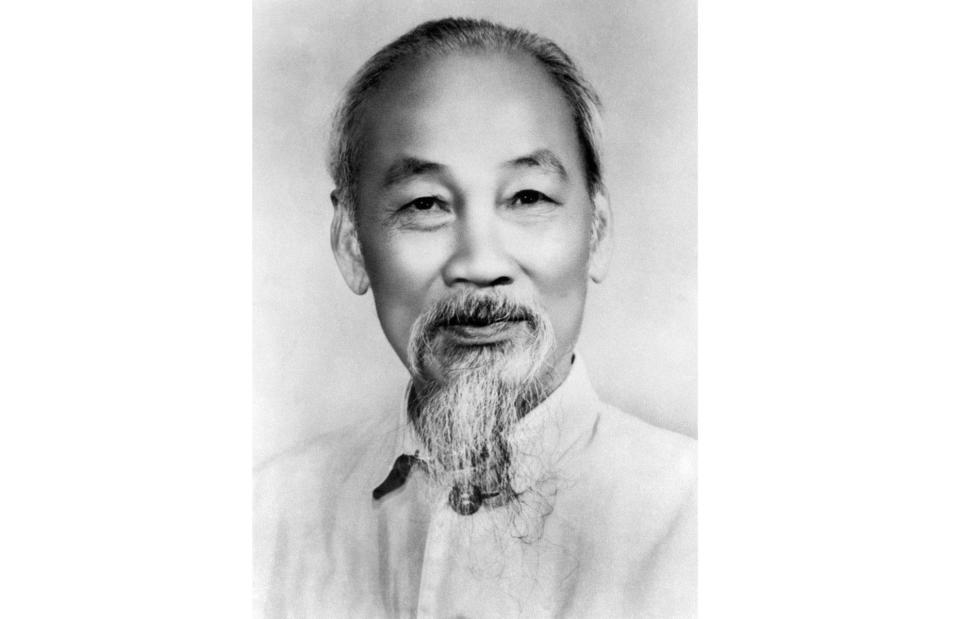
AFP/Getty
Communist revolutionary Ho Chi Minh, who declared independence from French Indochina in 1945, captured much of northern Vietnam by the early 1950s and defeated the former colonial power in 1954. The peace talks that followed granted Vietnam independence and split the country into two zones, North Vietnam and South Vietnam, with elections planned for 1956 that would unite them.
South Vietnam (1955–1975)

AFP/Getty
The South's anti-communist leader Ngo Dinh Diem refused to hold the reunification elections and the North reacted by starting the bloody 20-year Vietnam War. Despite the involvement of US, Australian and Thai forces, the South was defeated by the Soviet Union and China-backed North, and the two zones were forcibly united in 1976 to create the Socialist Republic of Vietnam.
United Arab Republic (1958–1971)
![<p>Unknown author [Public domain], via Wikimedia Commons</p>](https://s.yimg.com/ny/api/res/1.2/3BHySzLqSv2TAgSEhEMyww--/YXBwaWQ9aGlnaGxhbmRlcjt3PTk2MDtoPTYxOQ--/https://media.zenfs.com/en/loveexploring_uk_835/79646c74eefd9bb976c2d9c777616367)
Unknown author [Public domain], via Wikimedia Commons
Egyptian President Gamal Abdel Nasser dreamed of establishing a powerful pan-Arab state based on socialist principles, and got the ball rolling in 1958 with the creation of the United Arab Republic (UAR), a union comprised of Egypt and Syria.
United Arab Republic (1958–1971)

Derzi/AFP/Getty
The union itself lasted just three years. Egypt's dominance of the UAR and Nasser's socialist policies resulted in a backlash from the Syrian elite, and a coup ended the alliance in 1961. Egypt, however, retained the name for another 10 years.
Rhodesia (1965–1979)
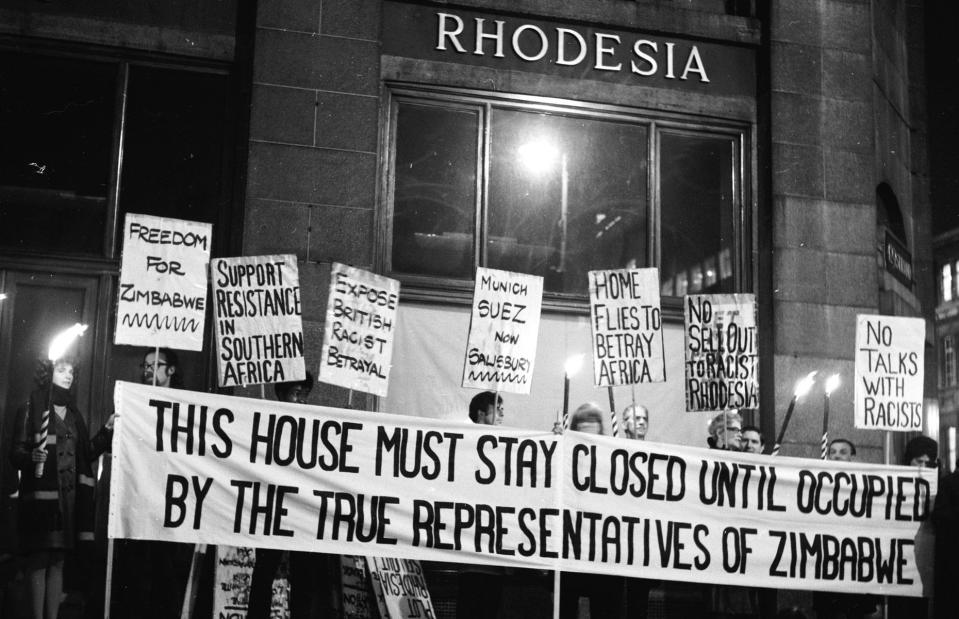
Central Press/Getty
Anxious to remain in power as Africa was decolonising, the white-minority government of South Rhodesia, which had been a UK colony since 1923, declared independence unilaterally in 1965. Though never recognised internationally, the illegal nation was a de facto country for 14 years.
Rhodesia (1965–1979)
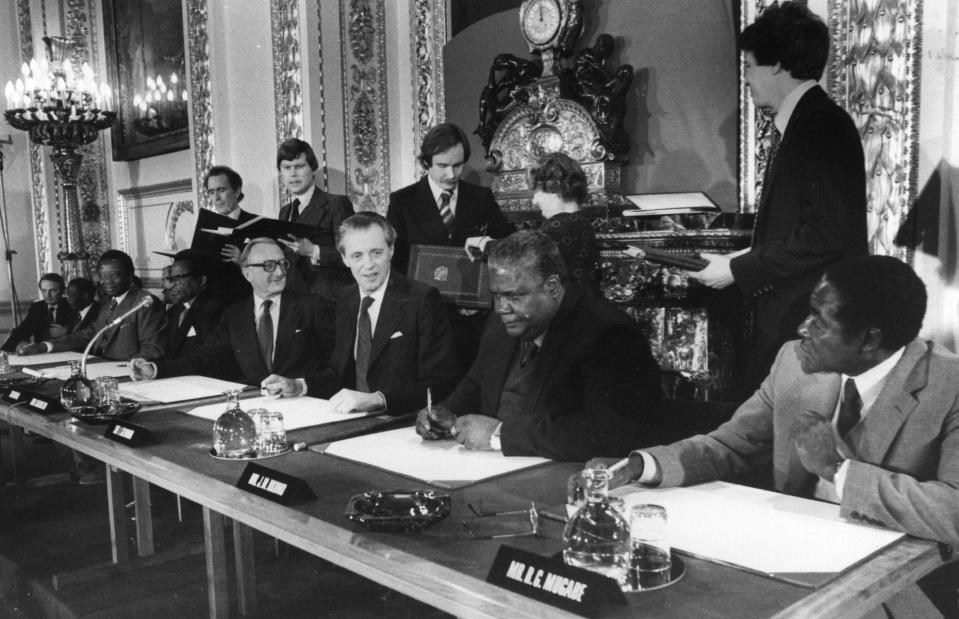
Central Press/Getty
Resistance to the regime was fierce. The ensuing conflict was fought out between the Rhodesian government, Marxist-Leninist ZIPRA and Robert Mugabe's ZANU, which emerged victorious. Hostilities ceased in 1979, ending white-minority rule, and the Republic of Zimbabwe was formally created the following year.


